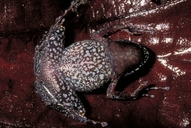|
Arthroleptis bioko Blackburn, 2010
Bioko Squeaker Frog | family: Arthroleptidae genus: Arthroleptis |
| Species Description: Blackburn DC 2010 A new squeaker frog (Arthroleptidae: Arthroleptis) from Bioko Island, Equatorial Guinea. Herpetologica 66:320-334. | |
 © 2010 Robert C. Drewes (1 of 2) |
|
|
|
Description DIAGNOSIS: Arthroleptis bioko is about 1.25 times bigger than other similar species in the Arthroleptis genus. The back legs and toes of this animal tend to be longer than most similar species and they can also be distinguished from other similar species by unique color markings on the ventral side of the body. Lastly, the males have white, spiny projections on the lower legs that are not present in other species (Blackburn 2010). COLORATION: In life, the overall background color is dark grayish-brown. The spots on the dorsal side can be light brown or yellow and there may be some dark brown or black patches as well. The spiny projections on the posterior back and sides of the body are white. The spots on the ventral side are off-white. The iris of the eye is yellowish and the pupil is black (Blackburn 2010). In alcohol, the background color of is medium-brown over the whole body. There are blotchy spots of light-brownish gray on the dorsal side of the frog as well as a few well-defined darker brown spots. The same coloring is seen on the dorsal side of the legs. The ventral side has many small, unevenly shaped, off-white spots with well-defined edges. The same coloring is seen on the ventral side of the legs. The iris and pupil are gray. The tympanum is brown and slightly transparent. The tips of the toes and fingers have no pigment. The underside of the mouth is completely rimmed with white blotchy marks (Blackburn 2010). VARIATION: Although no females were collected for the species description, photographs of females exist. From those photographs, males appear to have several characters that are not present in females. Males have a lengthened third finger and spiny projections on the groin area and toes. The skin around their throat is also stretched and darker in color. It was not possible to evaluate size dimorphism from the photographs (Blackburn 2010). Distribution and Habitat Country distribution from AmphibiaWeb's database: Equatorial Guinea
Life History, Abundance, Activity, and Special Behaviors Information about reproduction is limited, but A. bioko is assumed to be a direct developer, similar to the other species in the same clade (IUCN 2012). Males have been found calling during the day in the rain, but there is no official record of its calling (Blackburn 2010). Trends and Threats Arthroleptis bioko are found in conservation areas that are under legal protection; specifically the forests of Bioko, the Reserve Scientifique de la Caldera de Luba, and the Pico de Basilé National Park. However, new law changes might affect the conservation efforts in place (IUCN 2012). Possible reasons for amphibian decline General habitat alteration and loss Comments The specific epithet, “bioko,” refers to Bioko Island, the location where this species is found (IUCN 2012, Blackburn 2010). The common name for A. bioko is the “Bioko squeaker frog” (IUCN 2012, Blackburn 2010).
References
Blackburn, D. C. (2008). “Biogeography and evolution of body size and life history of African Frogs: Phylogeny of squeakers (Arthroleptis) and long-fingered frogs (Cardioglossa) estimated from mitochondrial data.” Molecular Phylogenetics and Evolution, 49(3), 806–826. [link] Blackburn, D. C. (2010). “A new squeaker frog (Arthroleptidae: Arthroleptis) from Bioko island, Equatorial Guinea.” Herpetologica, 66(3), 320-334. [link] IUCN SSC Amphibian Specialist Group. 2015. Arthroleptis bioko. The IUCN Red List of Threatened Species 2015: e.T16575406A16575409. http://dx.doi.org/10.2305/IUCN.UK.2015- 2.RLTS.T16575406A16575409.en. Accessed 20 February 2022. Originally submitted by: Mona Wong, Beatrice Harvey (2022-07-29) Description by: Mona Wong, Beatrice Harvey (updated 2022-07-29)
Distribution by: Mona Wong, Beatrice Harvey (updated 2022-07-29)
Life history by: Mona Wong, Beatrice Harvey (updated 2022-07-29)
Trends and threats by: Mona Wong, Beatrice Harvey (updated 2022-07-29)
Comments by: Mona Wong, Beatrice Harvey (updated 2022-07-29)
Edited by: Ann T. Chang (2022-07-29) Species Account Citation: AmphibiaWeb 2022 Arthroleptis bioko: Bioko Squeaker Frog <https://amphibiaweb.org/species/7529> University of California, Berkeley, CA, USA. Accessed May 31, 2025.
Feedback or comments about this page.
Citation: AmphibiaWeb. 2025. <https://amphibiaweb.org> University of California, Berkeley, CA, USA. Accessed 31 May 2025. AmphibiaWeb's policy on data use. |


 Map of Life
Map of Life